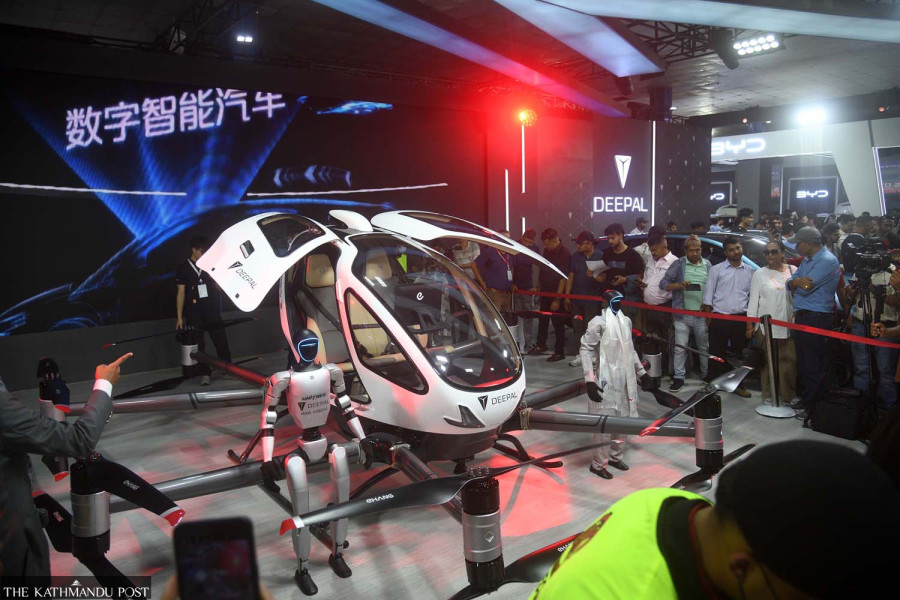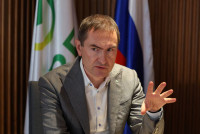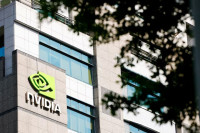Science & Technology
It’s a bird. No, it’s a plane. No, actually, it’s a Chinese flying car
The Deepal two-seater eVTOL aircraft, showcased for the first time in Nepal, draws crowds.
Suraj Kunwar
A flying taxi stole the spotlight at this year’s NADA Automobiles Association of Nepal Auto Show, turning what is usually a showcase of shiny new cars into a glimpse of the future of transport.
The two-seater electric vertical take-off and landing (eVTOL) aircraft, branded the Deepal Flying Taxi, arrived from Shanghai only days before the show and immediately became its star attraction.
The Chinese-made model, jointly developed by automaker Changan and aviation company EHang, drew crowds of curious visitors, excited entrepreneurs, and even Prime Minister KP Sharma Oli, who inspected the machine alongside Finance Minister Bishnu Paudel.
Bishnu Kumar Agrawal, managing director of MAW Group, the authorised distributor of Changan vehicles in Nepal, said the flying taxi can be controlled from a single command area, and no pilot is needed inside it.
Considered China’s second competitor in the automobile industry after BYD, Changan has called it a ‘drone car designed for urban air mobility.’ The model displayed at the exhibition is a two-seater flying car.
The EH216-S model on display can carry up to 600 kilogrammes, reach speeds of 135 kilometres per hour, and fly 30 kilometres or 25 minutes on a single charge. It has eight motors; even if six fail, it can remain airborne. Its transparent carbon-fibre cabin and modern design provide a panoramic sky view.
“This aircraft is designed for urban air mobility,” said Agrawal. “It is fully automated, and advanced safety systems are built into it.”
After the exhibition, the flying taxi will be returned to China. The sale of the car in Nepal, priced at a minimum of Rs80 million, is yet to begin. MAW said the display aims to inspire scientific curiosity and innovation among Nepal’s youth.
“This is more than a flying car; it marks a step towards the future of transportation. Just as human mobility evolved from walking to trains, the next frontier is the sky. With planned development, Nepal could use this technology to transform tourism, emergency services, and urban planning,” said Agrawal. “China is finalising flight preparations, and the UAE will soon deploy it.”
The Civil Aviation Authority of Nepal (CAAN) also commented on the development. “With rising traffic congestion and urbanisation worldwide, flying cars can offer faster, safer, and more environment-friendly travel. In a mountainous country like Nepal, its potential is even higher. However, before they can operate here, essential infrastructure—including charging stations, designated air corridors, traffic management systems, and aviation regulations—must be established,” said Gyanendra Bhul, spokesperson for the CAAN.
Vivek Sikaria, managing director of MAW Vriddhi Commercial Vehicle, emphasised the practical applications of flying taxis. “It is ideal for point-to-point travel, tourism observation, and surveys. Deepal’s stall attracted the largest crowd at the exhibition. Nepali youth showed great enthusiasm, closely observing the taxi, asking questions, and taking photos and videos.”
MAW also introduced humanoid robots in Nepal. “These robots interact directly with visitors, perform human-like activities, and offer a realistic experience,” Sikaria said.
Globally, the concept of flying taxis is gaining momentum. The New York Times reported that in 2020, Hyundai and Uber announced plans to develop fully electric flying taxis in Las Vegas as part of the future of urban air rides. Automakers and aviation entrepreneurs have promised mass production of flying cars for decades.
The Deepal model has been in production for four years. According to Sikaria, around 400 units have already been sold in China.




 9.12°C Kathmandu
9.12°C Kathmandu










